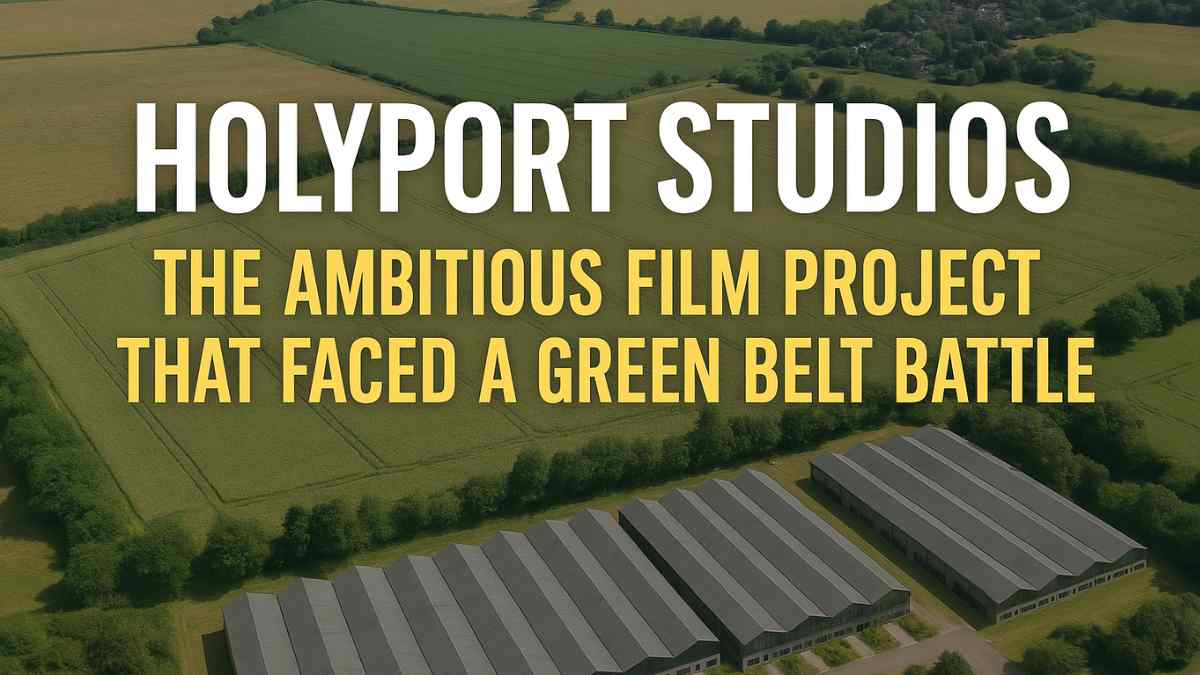Holyport Studios: The Ambitious Film Project That Faced a Green Belt Battle

The name Holyport Studios has echoed throughout the British entertainment and planning sectors over the past few years. What began as an ambitious proposal to establish one of the most advanced film and television production hubs in Berkshire soon became one of the most debated development projects in southern England. The story of Holyport Studios is a powerful example of how innovation, creativity, and ambition can meet head-on with environmental protection, planning law, and local community concerns.
The proposed studio complex was set to join the ranks of the UK’s most prestigious creative spaces such as Pinewood, Shepperton, and Bray. Yet, despite its impressive scale and promises of economic growth, Holyport Studios faced an unexpected and decisive roadblock — a firm rejection based on its location within the green belt.
The Vision Behind Holyport Studios
The concept for Holyport Studios emerged during a period of booming demand for film and television production spaces across the United Kingdom. With global streaming platforms expanding at lightning speed and the UK becoming a magnet for international film production, studio space had become a valuable commodity. The developers behind Holyport Studios envisioned a modern, sustainable production centre that would serve both domestic and international filmmakers.
Planned for the outskirts of Holyport village, near Maidenhead in Berkshire, the site covered more than forty hectares of land. The project promised around fifteen cutting-edge sound stages, extensive back-lot areas, production offices, workshops, and even a virtual production hub to cater for modern digital filmmaking techniques.
What made the plan particularly attractive was its potential to generate significant local employment. The developers claimed that the project would provide around 1,800 jobs during the construction phase and approximately 1,500 permanent roles once operational. The economic injection for the surrounding region was projected to be in the tens of millions annually, contributing directly to the Royal Borough of Windsor and Maidenhead’s economic development goals.
Sustainability and Innovation
A core part of the Holyport Studios proposal was its commitment to sustainability. The developers promoted the project as a net-zero carbon design, integrating renewable energy systems and promising a biodiversity net gain through a proposed sixteen-hectare nature park adjacent to the studio complex.
Such features reflected an industry-wide trend toward greener production environments. The studio would have included electric vehicle infrastructure, solar energy integration, and the use of sustainable materials. The nature park element was particularly emphasised as a balance between economic growth and environmental preservation — offering local residents access to natural green space while providing habitats for wildlife.
The Economic Promise
Supporters of Holyport Studios highlighted the economic importance of expanding the UK’s film and television infrastructure. In 2021 alone, film and high-end television production spending in the UK reached nearly six billion pounds. Studios like Pinewood, Elstree, and Shepperton were operating at full capacity, and there was growing concern that the shortage of studio space could push international production to competing countries such as Hungary or Canada.
Holyport Studios was presented as a solution to this challenge. The project was expected to attract major production companies, boost tourism, and foster skills development. It also planned to include a “Berkshire Skills Hub”, providing apprenticeships and training programmes to help young people enter the media and entertainment sector. For the local community, the proposal seemed to offer both immediate and long-term employment opportunities, as well as the chance to position Berkshire as a key player in the UK’s creative economy.
Planning Challenges and Local Opposition
Despite the project’s ambitious design and potential benefits, not everyone shared the enthusiasm. From the start, Holyport Studios faced strong resistance from local residents, conservationists, and planning authorities.
The central issue revolved around its location — the site was within the designated green belt, a classification that exists to prevent urban sprawl and preserve open countryside. Under UK planning law, development on green belt land can only be approved under “very special circumstances”. Opponents argued that the project failed to meet this threshold.
Concerns were raised about the environmental impact, increased traffic congestion, loss of agricultural land, and potential damage to local wildlife habitats. Many residents expressed worries about how the vast construction project would alter the rural character of Holyport village. Public consultations and local meetings became increasingly tense as community groups demanded that the council uphold its responsibility to protect green belt areas.
The Planning Decision
In early 2023, Greystoke Land — the company behind the proposal — submitted a detailed planning application to the Royal Borough of Windsor and Maidenhead (RBWM). After months of review and extensive public feedback, the council’s planning committee met to deliver its verdict.
In March 2024, the committee voted unanimously to refuse planning permission. The decision was based on several key grounds: harm to the green belt, unsustainable transport links, loss of public rights of way, and inadequate environmental protection measures. The committee concluded that while the project offered economic benefits, these were not sufficient to outweigh the damage it would cause to the green belt.
The developers appealed the decision, hoping that the national government would overturn it. However, in June 2025, the Secretary of State upheld the council’s refusal. The government’s final decision stated that there was not enough evidence to demonstrate an urgent national need for additional studio space in that particular area and that alternative sites were available outside the green belt.
Reaction from the Industry
The refusal of Holyport Studios sparked mixed reactions across the film and television industry. Many professionals expressed disappointment, arguing that the decision represented a missed opportunity for the UK’s booming creative economy. They believed that modern facilities like Holyport Studios were crucial to maintaining the nation’s competitive edge in global production.
Others, however, saw the verdict as a necessary check on unsustainable development. Environmental advocates praised the planning authorities for prioritising the protection of the green belt, noting that economic growth should not come at the expense of irreplaceable natural landscapes. The debate highlighted a growing tension in modern Britain: balancing economic innovation with environmental and social responsibility.
Comparing with Other Studio Projects
The Holyport proposal was not the only large-scale studio project in the UK to face such challenges. Similar developments have emerged across the country, including Sky Studios Elstree, Shinfield Studios near Reading, and Eastbrook Studios in Dagenham. While many of these projects have succeeded, they often benefited from being located on brownfield or previously developed land rather than protected countryside.
This comparison emphasises an important lesson for future developers: site selection can determine the fate of an entire project. Local authorities and communities are increasingly unwilling to sacrifice green belt areas, no matter how promising the economic projections may be.
The Broader Impact on Planning Policy
The story of Holyport Studios extends beyond a single failed project. It reflects broader national conversations about how the UK balances growth, creativity, and environmental stewardship.
On one side, the creative industries remain one of Britain’s fastest-growing sectors, supporting hundreds of thousands of jobs and contributing billions to the economy. On the other, green belt protection is deeply embedded in the national planning framework and public consciousness.
For many planners and policymakers, the Holyport case serves as a reminder that sustainability must remain central to development. Ambitious projects can still thrive, but they must align with local character, infrastructure capacity, and environmental priorities.
What Could Have Been
Had the Holyport Studios project gone ahead, it would have transformed Berkshire’s position in the global entertainment industry. The site’s proximity to Heathrow Airport and London made it an ideal logistical location. Combined with cutting-edge production technology, sustainable design, and a dedicated skills hub, it had the potential to attract international blockbusters, streaming series, and advertising productions.
The economic ripple effects would have benefited countless local businesses — from hospitality to transport, from construction to education. Yet, despite the vision, it was the chosen location that ultimately defined its outcome.
Lessons for Future Developments
The failure of Holyport Studios provides several key lessons for future infrastructure proposals. First, developers must ensure that projects of national significance are backed by clear, demonstrable needs and robust evidence that alternative locations have been properly assessed. Second, genuine community engagement is vital. Many large-scale developments falter because residents feel excluded or unconvinced by corporate promises.
Third, environmental integration must be more than a design feature — it should be the foundation of the project. From carbon reduction strategies to biodiversity enhancement, sustainability must prove its worth beyond marketing language.
Finally, developers must remember that public trust is as valuable as financial investment. Projects that win local confidence often have a better chance of overcoming planning challenges.
The Legacy of Holyport Studios
Although Holyport Studios will not materialise in its proposed form, its story will likely influence future discussions about the intersection of creativity and conservation. The refusal demonstrated that even well-intentioned and economically appealing proposals can fall short if they conflict with planning ethics and environmental law.
For the film and television industry, it serves as a reminder that expansion requires careful navigation through the complex landscape of UK planning regulation. For local authorities, it shows that communities can successfully defend their green spaces when united under a common cause.
Conclusion
The tale of Holyport Studios is one of ambition, innovation, and challenge. It symbolises the aspirations of a creative nation eager to lead the global entertainment world, yet bound by its commitment to preserving the countryside that defines its heritage.
While the project promised jobs, training, and investment, it could not overcome the barriers of location and policy. The refusal of Holyport Studios is not simply the end of a development plan — it is a reflection of the values that shape modern Britain: a country striving to balance progress with preservation.



